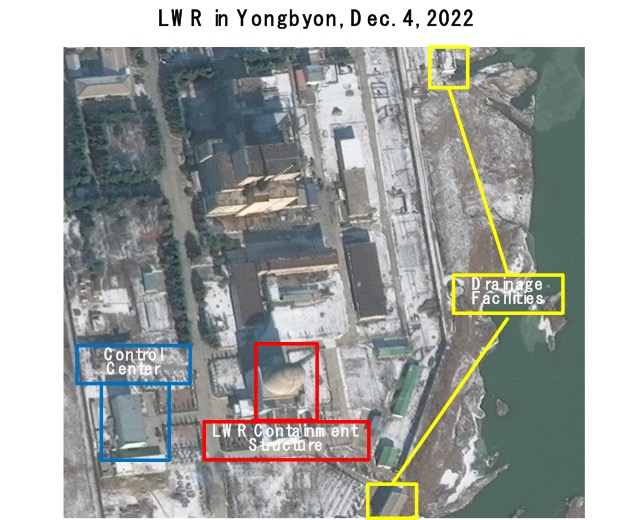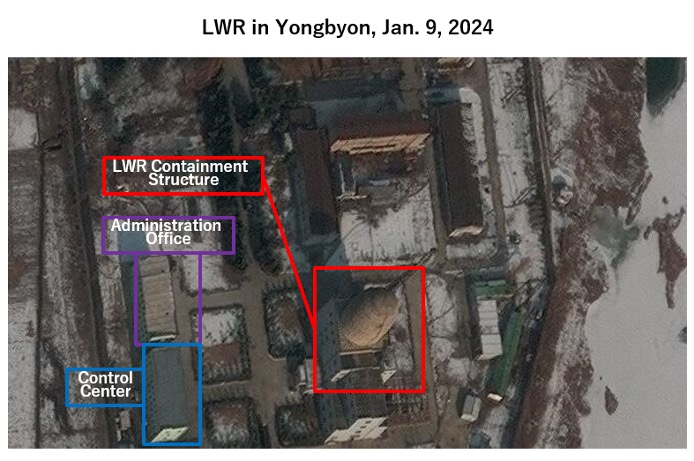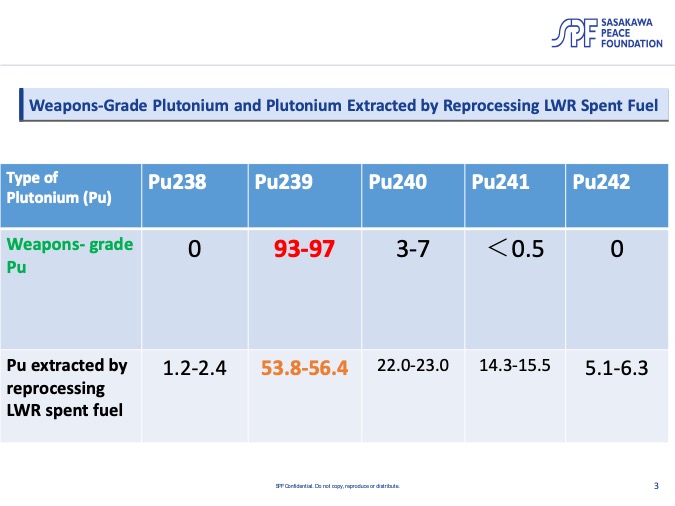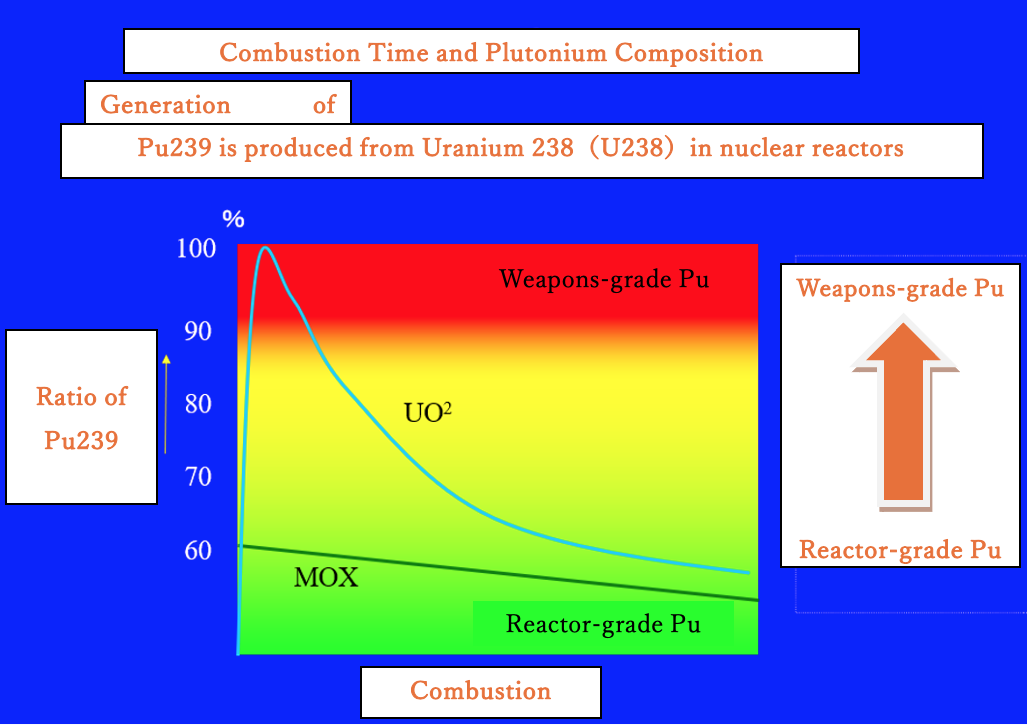Satellite Imagery Analysis 2024/02/14
North Korean LWR Achieves Criticality
Can LWRs Produce Weapons-Grade Plutonium?
Yuki Kobayashi (Research Fellow, Sasakawa Peace Foundation)
1. New Concerns about North Korea
In late December 2023, International Atomic Energy Agency (IAEA) Director General Rafael Mariano Grossi issued a statement revealing that there were indications that the light water reactor (LWR) under construction in Yongbyon, North Korea had reached criticality.[1] Criticality is a sustained fission chain reaction, or a sustained generation of heat and radioactive substances through nuclear fission, indicating the reactor has started operation. The statement expressed the concern that plutonium could be separated by reprocessing spent fuel for use in nuclear weapons.
The classification of nuclear reactors is based on the moderator used to slow down the release of neutrons for efficient fission of nuclear fuel. LWRs are reactors filled with normal water (called light water to differentiate from heavy water with greater density) that use uranium as fuel. Using water as neutron moderator, a massive amount of steam is generated by heat to drive turbines for power generation. At present, over 80% of nuclear reactors in the world are LWRs, and all operating reactors in Japan are LWRs.
Plutonium extracted from spent fuel in LWRs used to be regarded as difficult to convert into nuclear arms. As a result, LWRs were thought to be conducive to achieving both nuclear nonproliferation and peaceful use of atomic energy, which was why they became the dominant type of reactor in the world. As a matter of fact, after the first North Korean nuclear crisis in the first half of the 1990s [2] was resolved with the U.S.-DPRK agreement, the provision of LWRs to North Korea was agreed upon. So, why has the operation of this LWR led to concerns about conversion to nuclear weapons now? Is it really difficult to convert plutonium extracted from spent fuel in LWRs for use as nuclear arms? The answers to these questions will have great significance for Japan and the international community not only in terms of understanding the intentions of North Korea’s nuclear and missile development, but also for pursuing the peaceful use of atomic energy in the future.
This article analyzes the new satellite images obtained by the Sasakawa Peace Foundation of nuclear facilities in Yongbyon and refers to the opinions of IAEA and experts on nuclear substances in an attempt to answer the above questions.
2. Construction of LWR in Yongbyon
Satellite Image No. 1 of the Yongbyon LWR construction site below was taken on Dec. 4, 2022, while Satellite Image No. 2 of the same site was taken on Jan. 9, 2024.

Satellite Image No. 1

Satellite Image No. 2
Construction of the containment structure with a distinctive round roof housing the LWR (marked in red) can be seen to be almost completed as of the end of 2022. (Satellite Image No. 1). Furthermore, the control center (marked in blue) for the LWR’s operations had also been completed at this stage. In the latest image taken in January this year, another building, which is thought to be an administration office for business other than the operation of the reactor (marked in purple), is also in place.
Furthermore, since nuclear power generation requires the circulation of a large amount of water to cool the reactors, they are built near water sources. A river can be seen here on the right side of Image 1, and drainage facilities (marked in yellow) managing the discharge of circulated water used as reactor coolant can also be seen. Discharged water provided an important indication for IAEA to determine that “the reactor has reached criticality.” After North Korea threw out its inspectors in 2009, IAEA has mainly been monitoring the DPRK through satellites. From an analysis of satellite images showing distribution of temperatures and other relevant materials, IAEA has detected high temperature from water flowing into the river from the vicinity of the drainage facilities.[3] This is proof that the reactor has reached a high temperature, thus heating the water circulated around it, indicating that the reactor is operating. In light of the IAEA director general’s statement, the South Korean Ministry of Defense indicated that “North Korea’s LWR is expected to be officially operational by summer 2024.”[4]
North Korea’s LWR construction plan dates back to the U.S.-DPRK agreement after the first nuclear crisis in the 1990s. Under this agreement, the Korean Peninsula Energy Development Organization (KEDO) was created in March 1995, which committed to provide two LWRs to North Korea. After 2000, with North Korea embarking on the production of highly enriched uranium that could be used to make nuclear arms and conducting nuclear experiments, thus accelerating its nuclear arms development, KEDO halted its plan to provide LWRs completely in 2006. In light of this, North Korea announced in 2009 its own plan to build the LWR that is now showing signs of achieving criticality. This reactor has the capacity to generate 100 megawatts of power, which is about one-tenth of the capacity of some of the LWRs that have resumed operation in Japan, such as Reactor No. 3 (890 megawatts) at Shikoku Electric Power Company’s Ikata Nuclear Power Plant or Reactors No. 3 and 4 (1,180 megawatts) at Kyushu Electric Power Company’s Genkai Nuclear Power Plant.
3. Observations on Nuclear Armament with Plutonium from LWRs
(1) Composition of Weapons-Grade Plutonium
Plutonium is a radioactive substance that is generated from uranium fuel by absorbing neutrons in the nuclear reactor. In other words, it does not exist in nature and is produced through nuclear fission of uranium, although the composition of plutonium depends on the speed of fission and combustion time in the reactor. As seen in Table 1, the ratio of plutonium-239, which releases tremendous energy, in weapons-grade plutonium is above 90%.
Table 1 Plutonium Composition

Weapons-grade plutonium can be obtained from spent fuel irradiated in graphite reactors or fast breeder reactors. Graphite reactors use graphite (material for making pencil lead) as neutron moderator. Since natural uranium can be used directly as fuel in these reactors, there is no need to process fuel, and weapons-grade plutonium can easily be obtained by reprocessing spent fuel. The U.S. and other nuclear powers all used graphite reactors to produce plutonium in the initial phase of their nuclear arms development. This is also the case for North Korea. On the other hand, the ratio of uranium-235, the fissile isotope that can sustain a chain reaction in the reactor, is a mere 0.7% of natural uranium fuel, which burns out in a few weeks. This produces only a tiny amount of plutonium, only 1 gram from one spent fuel rod from a graphite reactor. For this reason, it is necessary to replace a great amount of fuel repeatedly for combustion.
In FBRs, where nuclear fission is literally fast, it is possible to obtain over 100 kilograms of quality weapons-grade plutonium each year depending on the size of the reactor. China started the construction of a FBR on the coast of Fujian Province facing Taiwan in 2017, and this reactor is believed to be operating. (See Yuki Kobayashi, “China’s Fast Breeder Reactor Operating? Possibility of Accelerating Nuclear Arms Race”) However, it is difficult to manage liquid sodium used to cool FBRs. This is a technology in which stable operation is difficult to achieve, and this has prompted Japan and other Western countries to drop or suspend their development plans.
Graphite reactors and FBRs both have advantages and disadvantages. This shows that it is not easy to produce plutonium suitable for application in nuclear weapons.
(2) Distinctive Features of Plutonium Extracted from LWR Spent Fuel
Meanwhile, since LWRs use fuel with 5% concentration of uranium-235, they have a longer operating cycle than graphite reactors and can run throughout the year. Because they have a long combustion time, plutonium extracted by reprocessing spent fuel from LWRs contains different isotopes. The ratio of plutonium-239 stands at over 50% and plutonium-238, -242, and various other isotopes that are not weapons-grade are also found. (See Table 1) The presence of various isotopes is an obstacle to nuclear armament. Plutonium- 238, in particular, is characterized by spontaneous fission which produces heat. This could reach a temperature of 200 degrees, which causes the malfunctioning of the detonator used for plutonium-239 explosion. For this reason, it cannot be stored for any length of time after being assembled into a nuclear weapon ready for use in an operation. This is also the reason why it is assumed that “nuclear armament using plutonium extracted from LWRs is difficult.” The U.S., which has conducted nuclear explosion experiments more than 1,000 times, and other nuclear powers have not been known to conduct any nuclear explosion experiments using plutonium from LWRs.
However, the above does not mean that nuclear armament using plutonium derived from LWRs is not possible. For example, even if the plutonium and detonator are kept separately, if the technology to assemble them in half a day in an emergency is established, they can still function as nuclear weapons. Moreover, theoretically, it is possible for LWRs to produce virtually weapons-grade plutonium by shortening the fuel combustion time. Secretary General Tomonori Iwamoto of the Institute of Nuclear Materials Management Japan Chapter estimated that, “Combustion of nuclear fuel for one year in a 100 megawatt-class LWR can produce around 20 kilograms of plutonium with a composition equivalent to that in the lower row in Table 1. By replacing the fuel two or three times a year to shorten combustion time, although the total amount of plutonium will be less than 20 kilograms, 4-6 kilograms of weapons-grade plutonium can be obtained.” This amount is roughly equivalent to North Korea’s annual production of weapons-class plutonium with its graphite reactors in Yongbyon. Since making one nuclear warhead requires 3.5±0.5 kilograms of weapons-class plutonium, this amount translates into a little less than two warheads per year.
4. Implications for Japan and the International Community
Nuclear armament using plutonium extracted from LWR spent fuel not only damages the detonator due to the presence of heat-emitting isotopes, but also runs the risk of self-destruction, so this process is barred by many restrictions, such as the difficulty of assembling. There are also many technical issues in producing weapons-grade plutonium from LWR fuel. For example, this will require pulling out still combustible fuel, which runs the risk of massive leakage of radioactive substances. If despite such obstacles, North Korea still intends to extract plutonium from LWRs for military purposes, the international community needs to investigate the underlying reasons.
First, it is possible that North Korea wants to accelerate the nuclear arms race. SIPRI Yearbook 2023 published by the Stockholm International Peace Research Institute estimates that North Korea has 30 nuclear warheads. It is possible that in addition to graphite reactors, it wants to upgrade its capacity to produce nuclear warheads by using LWRs to extract plutonium. Second, the operation of its graphite reactors is reaching their limit. The construction of the nuclear facilities in Yongbyon started in the 1960s, and the graphite reactors were built in the 1980s with the cooperation of the former Soviet Union.[5] It is possible that North Korea is experimenting with extracting plutonium with LWRs to replace the graphite reactors in anticipation of the reduced capacity or termination of plutonium production after these reactors have been in operation for nearly 40 years. In any case, it is necessary to closely watch developments from now on, discern North Korea’s intent, and consider responses.
Considering LWRs are the dominant type of reactor in the world at present, the events in Yongbyon raise questions about the peaceful use of atomic energy. The fact that nuclear armament with plutonium derived from LWRs cannot be ruled out means that the peaceful use of atomic energy can only be guaranteed if the inspection regime of IAEA, the nuclear watchdog, thoroughly covers all countries of the world. With more and more countries expected to introduce new LWRs as part of their effort to deal with climate change, how will the IAEA enhance its inspection regime? How should the international community cooperate to increase its budget and manpower?
Japan is a country authorized to extract plutonium by reprocessing spent fuel for reuse in nuclear reactors. It has a history of fully cooperating with IAEA in the establishment of monitoring technology and inspection of nuclear facilities. It has great potential to contribute to the international community in guaranteeing the peaceful use of nuclear energy.
1 “IAEA Director General Statement on Recent Developments in the DPRK’s Nuclear Programme” December/21/2023. [https://www.iaea.org/newscenter/pressreleases/iaea-director-general-statement-on-recent-developments-in-the-dprks-nuclear-programme]
2 After the end of the Cold War, North Korea signed a NPT Safeguards Agreement (accepting inspection of nuclear facilities) with IAEA in January 1992. However, discrepancies of its declaration with IAEA inspection results were found, e.g. the existence of two undeclared facilities suspected of developing nuclear arms. IAEA demanded “special inspection” of these facilities, but North Korea refused and eventually announced its withdrawal from the Nuclear Nonproliferation Treaty (NPT) in March 1993, raising concerns about its nuclear arms development in the international community.
3 See Note 1.
4 “North Korea's new reactor at nuclear site likely to be formally operational next summer, Seoul says,” The Mainichi, December/30/2023. [https://mainichi.jp/english/articles/20231230/p2g/00m/0in/027000c]
5 Encyclopedia of Atomic Energy ATOMICA. [https://atomica.jaea.go.jp/data/detail/dat_detail_14-02-02-01.html] (in Japanese)
Combustion Time and Plutonium Composition
Generation of Pu239






